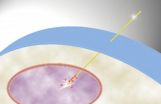(Press-News.org) ROCHESTER, Minn. -- In one of the first studies to focus exclusively on the outcomes after treatment for patients with high-risk prostate cancer,(http://www.mayoclinic.org/prostate-cancer/) researchers have found that surgery provides high survival rates. Collaborating researchers at Mayo Clinic and Fox Chase Cancer Center (http://www.fccc.edu/) in Philadelphia discovered that patients with the most aggressive forms of prostate cancer who had radical prostatectomy procedures had a 10-year cancer-specific survival rate of 92 percent and an overall survival rate of 77 percent.
The cancer-specific survival rate for patients who had radiation therapy alone was 88 percent and the overall survival rate was 52 percent. The findings were presented today at the North Central Section of the American Urological Association's 84th Annual Meeting held in Chicago (http://www.ncsaua.org/).
"It's long been believed that patients with aggressive prostate cancer are not candidates for surgery," says Stephen Boorjian, M.D., (http://www.mayoclinic.org/bio/14373041.html) a Mayo Clinic urologist. "We found that surgery does provide excellent long-term cancer control for this type of prostate cancer. In addition, by allowing the targeted use of secondary therapies such as androgen deprivation, surgery offers the opportunity to avoid or at least delay the potentially adverse health consequences of these treatments."
Of the 1,847 patients with aggressive prostate cancer (as defined by the National Comprehensive Cancer Network) included in the study from 1988 to 2004, 1,238 underwent surgery at Mayo Clinic and 609 were treated with radiation therapy at Fox Chase Cancer Center. Of the 609 receiving radiation therapy, 344 also received androgen deprivation therapy.
Researchers analyzed their cancer-specific and overall survival rates. The cancer-specific survival rate was equal for those who had surgery and those treated with radiation plus hormone therapy (92 percent). However, the overall survival rate was significantly better for those who had
the surgery (77 percent) than those who had radiation plus hormones (67 percent) or those who had radiation alone (52 percent).
"Patients with radiation and hormone therapy were 50 percent more likely to die than patients who had surgery," says Dr. Boorjian. "This was true even after controlling for patient age, comorbidities and features of the tumors. These results suggest that use of hormone therapy in patients who received radiation therapy may have had adverse health consequences.
"We want to stress that surgery provides excellent long-term control for high-risk prostate cancer patients," says Dr. Boorjian. "Limiting the need for hormones may avoid adverse health consequences. Further studies evaluating the differing impacts of treatments on quality of life and non-cancer mortality are necessary before we can determine the best approach for patients with aggressive prostate cancer."
###
Funding for the study was provided by the National Cancer Institute. Collaborators include R. Jeffrey Karnes, M.D.(http://www.mayoclinic.org/bio/12463493.html); Laureano Rangel; Eric Bergstralh, Ph.D.; and Michael Blute, M.D., all of Mayo Clinic; and Rosalia Viterbo, M.D.; Eric Horwitz, M.D.; and Mark Buyyounouski, M.D., all of Fox Chase Cancer Center.
About Mayo Clinic
For more than 100 years, millions of people from all walks of life have found answers at Mayo Clinic. These patients tell us they leave Mayo Clinic with peace of mind knowing they received care from the world's leading experts. Mayo Clinic is the first and largest integrated, not-for-profit group practice in the world. At Mayo Clinic, a team of specialists is assembled to take the time to listen, understand and care for patients' health issues and concerns. These teams draw from more than 3,700 physicians and scientists and 50,100 allied staff that work at Mayo Clinic's campuses in Minnesota, Florida, and Arizona; and community-based providers in more than 70 locations in southern Minnesota, western Wisconsin and northeast Iowa. These locations treat more than half a million people each year. To best serve patients, Mayo Clinic works with many insurance companies, does not require a physician referral in most cases and is an in-network provider for millions of people. To obtain the latest news releases from Mayo Clinic, go to www.mayoclinic.org/news. For information about research and education, visit www.mayo.edu. MayoClinic.com (www.mayoclinic.com) is available as a resource for your general health information.
Contact:
Amy Tieder
507-284-5005 (days)
507-284-2511 (evenings)
e-mail: newsbureau@mayo.edu
While the U.S. has made great progress in the prevention and treatment of tuberculosis, the nation has become more susceptible to potential epidemics of multidrug-resistant tuberculosis (MDR-TB), according a study led by Johns Hopkins researchers. Computer simulations show that as TB prevalence falls, the risk for more extensive MDR-TB increases. In addition, the simulation also showed that higher detection of TB cases without proper treatment of cases also increased risk. The study findings are published in the September 22 edition of the journal PLoS ONE. An interactive ...
Newport Beach, CA – September 27, 2010 – Hoag Memorial Hospital Presbyterian recently announced encouraging clinical study results for patient-specific vaccine therapy to treat metastatic melanoma. The study is ongoing, but the report concludes that patient-specific vaccines can sometimes induce durable complete regression of progressing soft-tissue melanoma metastases, as demonstrated in one particular patient who participated in the trial.
The study report, entitled: "Durable Complete Response of Refractory, Progressing, Metastatic Melanoma after Treatment with a ...
About ten years ago, the discovery of microRNAs ― tiny cellular molecules that regulate our genetic code ― unlocked a world of scientific possibilities, including a deeper understanding of human disease. One new analytical technology is "deep sequencing," which gives scientists the ability to discover invaluable information about human diseases at a genetic level. Now, Tel Aviv University researchers have developed the cutting-edge technology to better analyze these results.
The software, called miRNAkey, was developed by Roy Ronen as part of a team of researchers ...
Elevated concentrations of nitrogen and phosphorus, nutrients that can negatively impact aquatic ecosystems and human health, have remained the same or increased in many streams and aquifers across the Nation since the early 1990's, according to a new national study by the U.S. Geological Survey.
"This USGS report provides the most comprehensive national-scale assessment to date of nitrogen and phosphorus in our streams and groundwater," said Marcia McNutt, USGS Director. "For years we have known that these same nutrients in high concentrations have resulted in 'dead ...
URBANA – Tile drainage in the Mississippi Basin is one of the great advances of the 19th and 20th centuries, allowing highly productive agriculture in what was once land too wet to farm. In fact, installation of new tile systems continues every year, because it leads to increased crop yields. But a recent study shows that the most heavily tile-drained areas of North America are also the largest contributing source of nitrate to the Gulf of Mexico, leading to seasonal hypoxia. In the summer of 2010 this dead zone in the Gulf spanned over 7,000 square miles.
Scientists ...
INDIANAPOLIS – Not since victory gardens helped World War II era Americans on the home front survive food shortages have urban gardens been as necessary and popular as they are today. With more food production in cities, the safety of the produce grown there becomes increasingly important.
As city dwellers across the country are harvesting fruits and vegetables for family consumption and planning ahead for the next planting season, geochemist Gabriel Filippelli, Ph.D., professor of earth sciences at the School of Science at Indiana University-Purdue University Indianapolis, ...
CHAMPAIGN, Ill. — Getting an inside look at the center of a cell can be as easy as a needle prick, thanks to University of Illinois researchers who have developed a tiny needle to deliver a shot right to a cell's nucleus.
Understanding the processes inside the nucleus of a cell, which houses DNA and is the site for transcribing genes, could lead to greater comprehension of genetics and the factors that regulate expression. Scientists have used proteins or dyes to track activity in the nucleus, but those can be large and tend to be sensitive to light, making them hard ...
Electric cars hold greater promise for reducing emissions and lowering U.S. oil imports than a national renewable portfolio standard, according to research conducted by Rice University's Baker Institute for Public Policy.
This assessment is among several contained in a new major policy study the Baker Institute Energy Forum will release at a Sept. 27-28 conference titled "Energy Market Consequences of an Emerging U.S. Carbon Management Policy." The study comprises several academic working papers on a variety of topics, such as carbon pricing, the wind industry, global ...
Unlike nerves of the spinal cord, the peripheral nerves that connect our limbs and organs to the central nervous system have an astonishing ability to regenerate themselves after injury. Now, a new report in the October 1st issue of Cell, a Cell Press publication, offers new insight into how that healing process works.
"We know a lot about how various cell types differentiate during development, but after a serious injury like an amputation, nerves must re-grow," said Allison Lloyd of University College London. "They need a new mechanism to do that because the developmental ...
ALBUQUERQUE, N.M. – Sandia National Laboratories researchers have developed a new system to monitor how clouds affect large-scale solar photovoltaic (PV) power plants. By observing cloud shape, size and movement, the system provides a way for utility companies to predict and prepare for fluctuations in power output due to changes in weather. The resulting models will provide utility companies with valuable data to assess potential power plant locations, ramp rates and power output.
Sandia researchers' work is currently focused at the 1.2-megawatt La Ola Solar Farm on ...


